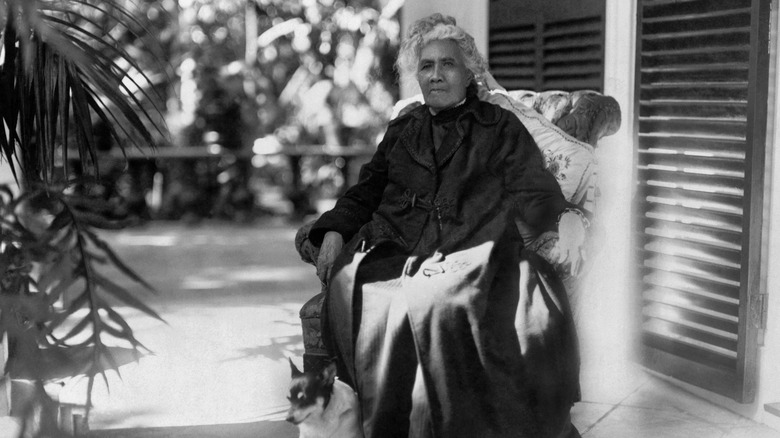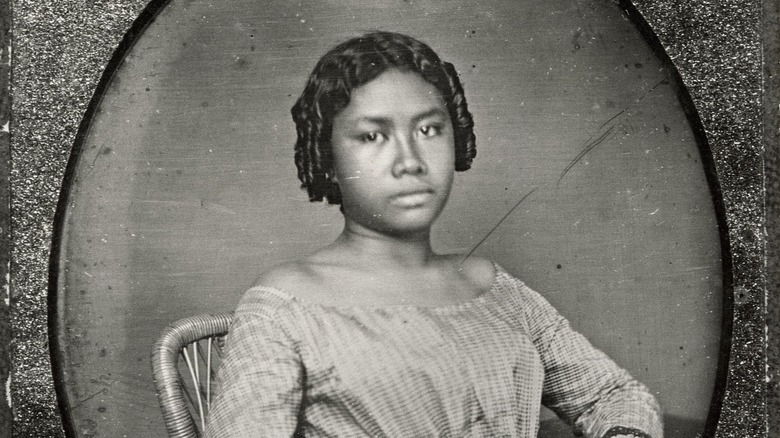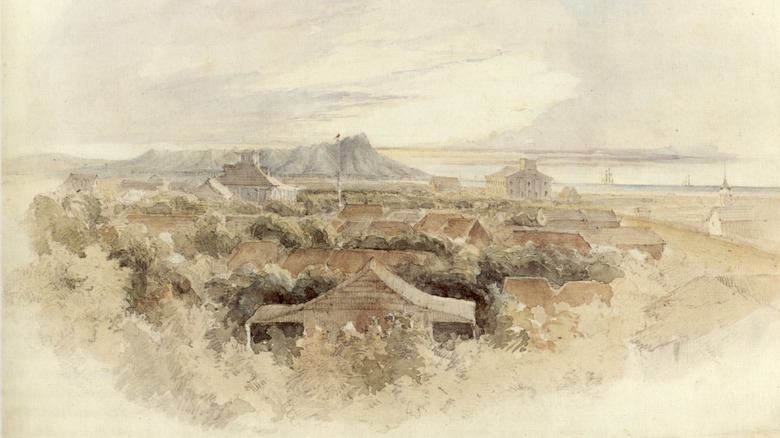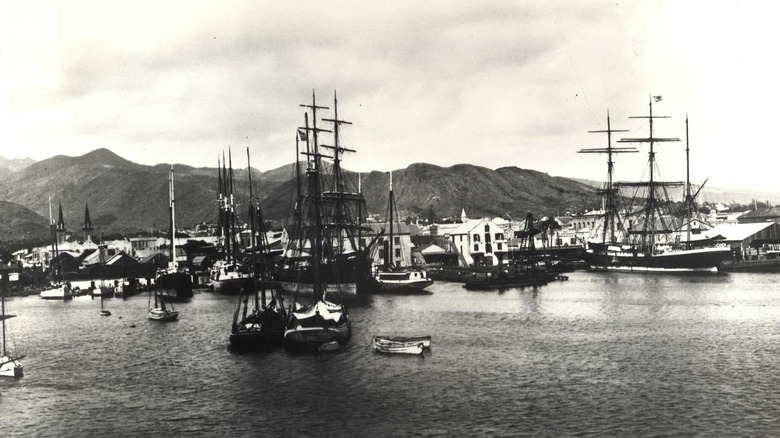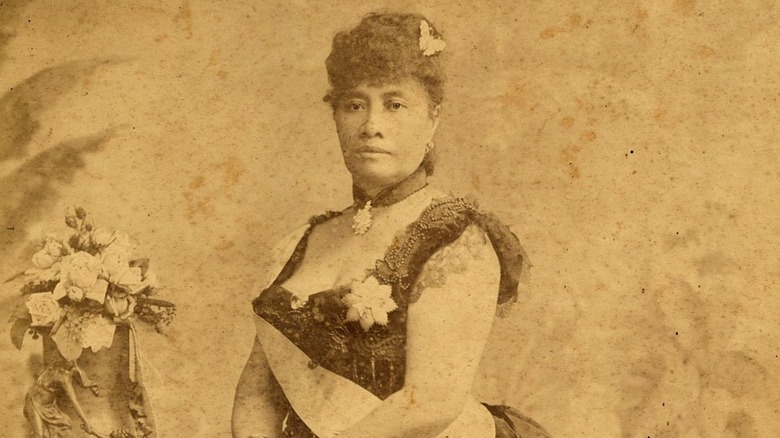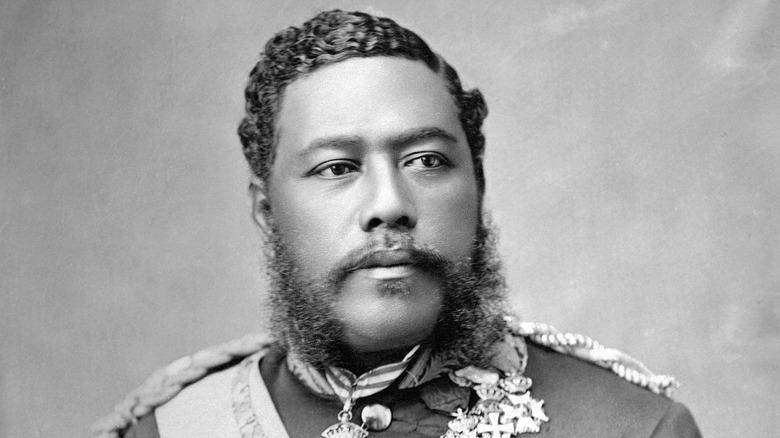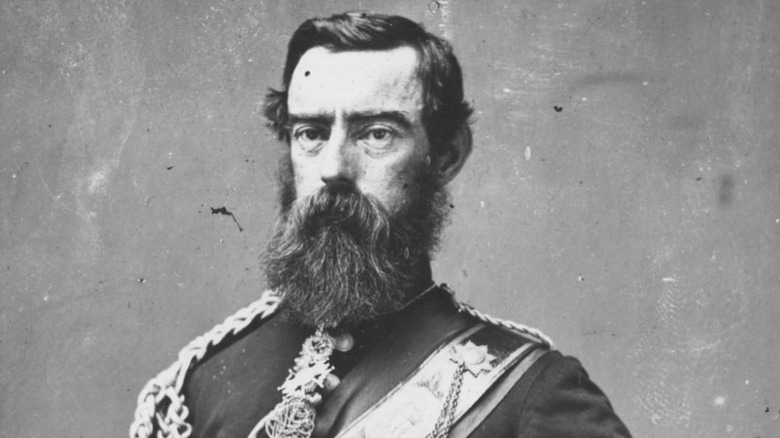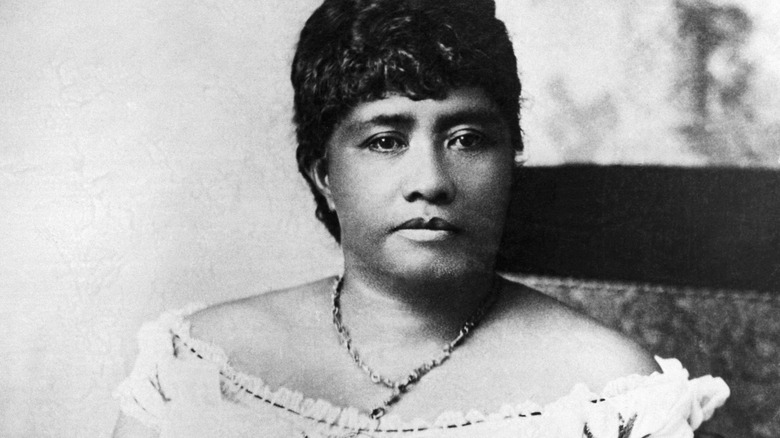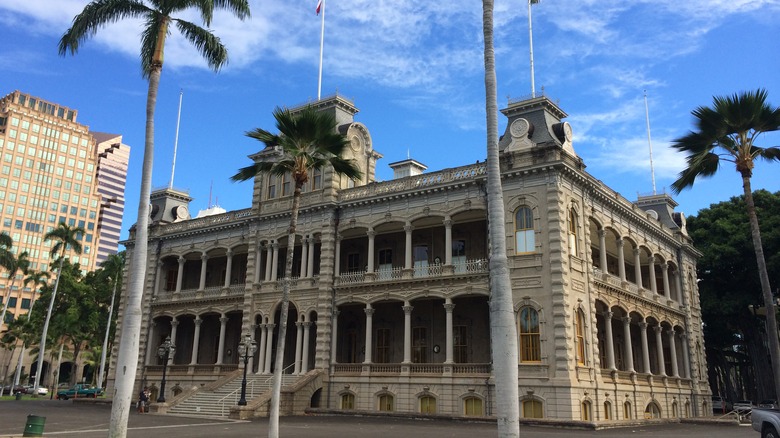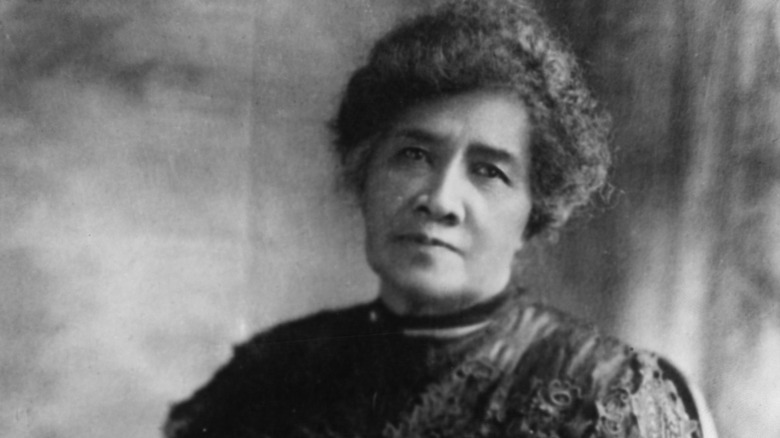Tragic Stories From The Life And Reign Of Hawaii's Last Monarch, Queen Lili'uokalani
"The cause of Hawaiian independence is larger and dearer than the life of any man connected with it." This defiant statement was written by Queen Lili'uokalani of Hawaii in her autobiography "Hawaii's Story by Hawaii's Queen." It encapsulates the rule of a queen who always tried to do her best for the people in her care, despite imperialist oppression and difficult personal struggles.
The beating heart of Native Hawaiian philosophy is Aloha 'Āina. Meaning "love of the land," this is the philosophy of caring for the land and understanding the interconnectedness of everything living on it. It's also what makes the story of Queen Lili'uokalani so heartbreaking. She lived through a turbulent period in Hawaiian history, as her people's land was forcibly taken away. During her life, Hawaii went from an independent nation to a U.S. territory, despite her best efforts to resist. Her story is a proud but tragic one, in which she lived her life tirelessly for her people's rights. In her own words, "It is for them that I would give my last drop of blood."
Her name wasn't always Lili'uokalani. Following Hawaiian tradition, she was named for the events surrounding her birth, and the king at the time had an eye infection. Accordingly, her birth name was Liliʻu Loloku Walania Kamakaʻeha, with the given name Lili'u meaning smarting, followed by words for tearful, burning pain, and sore eyes. In hindsight, it feels uncomfortably prescient that Hawaii's only queen was originally named for tears.
Unwelcome anglicization
Lili'u's early school experience wasn't a happy one. Like other Hawaiian nobility at the time, her education began at the Royal School, a boarding school where children were expected to adhere to Western values. The school expected her to speak in English, rather than her native language of Hawaiian, and behave like a white American at all times. At the school, she wasn't even addressed by her own name, going instead by her baptized Christian name of Lydia.
Children at the Royal School weren't treated well. They were often sent to bed hungry, with little more than a slice of bread with molasses for supper. Young Lili'u and the other children were forced to use their ingenuity to keep themselves well-fed. At times, they'd beg the cooks for extra food. If that didn't work, as a last resort, they'd sneak out at night to forage wild food for themselves. Hunting for edible roots and leaves in the gardens, they'd light cooking fires so they could satisfy their appetites without the school being aware of it.
The school also had some distinctly colonial motivations. The book "Pauahi: The Kamehameha Legacy" explains that the Royal School was set up by a Christian missionary couple without much teaching experience. Their main aim was to convert people to Christianity and Anglicize the Hawaiian children. Surrounded by a large wall, the children's contact with the outside world was limited to keep them away from the "bad" influence of their own culture.
Disease from overseas
In 1848, Hawaii was struck by an outbreak of measles. The disease had been previously unknown in the islands, and as a study in The Pediatric Infectious Disease Journal notes, island populations like those of Hawaii are particularly vulnerable to acute infections introduced from elsewhere. The 1848 measles outbreak would be the first of many, including other imported diseases like influenza and pertussis (whooping cough), which would ravage the Native population of the Hawaiian islands throughout the following decades. Around 10 years old at the time, young Lili'u found herself caught up in a devastating epidemic. About 10,000 people, mostly Native Hawaiians, would lose their lives to the disease, including Lili'u's 3-year-old sister Ka'imina'auao.
Lili'u's sister was the third of her family members to succumb to the disease, after Moses Kekūāiwa and William Pitt Leleiohoku. The urgent dangers of illness made an impact on many people in Hawaii, including its future queen. Later on, Lili'uokalani would recount, "This sad event made a great impression upon my younger days; for these relatives and companions of my youth died and were buried on the same day." This terrible year would come with just one silver lining, though. The Royal School declined in influence after 1848, and Lili'u would eventually be sent to a day school instead. While it was also run by an American missionary, she would enjoy a far more pleasant school life there.
Lili'uokalani's first challenge as queen
Lili'uokalani took the name she's best known by in 1877, when her brother King Kalākaua appointed her as the next heir to the throne of Hawai'i. Soon afterward, in 1881, Volume 3 of the book "The Hawaiian Kingdom" explains how Kalākaua left Hawaii to go on a world tour. He became the first and last Hawaiian leader to do so. As he departed, he left Lili'uokalani to act in his stead as Queen Regent, but this came with a serious unexpected challenge. Shortly after Kalākaua had gone, an outbreak of smallpox struck Honolulu.
Ruling alone for the first time, and with alarming encounters with epidemics in her past, Lili'uokalani was under pressure to take decisive action. She later explained, "Our past experience with the disease had shown us how fatal it might become to the Hawaiian people, and whatever the inconveniences, it became necessary at all hazards to prevent its spread." The 1882 Hawaiian Almanac notes that the disease caused much grief and hardship but was controlled by quarantine measures. These measures were imposed by the queen herself, confining the outbreak to the city of Honolulu while she also urged mass vaccinations to protect her people. In the end, the quarantines likely saved hundreds of lives across the island of O'ahu, but Lili'uokalani would certainly have faced heavy criticism for her actions. Most notably, her actions likely angered the wealthy business owners who would later work to topple her kingdom.
A revolution happened while she was gone
The beginning of the end for the Kingdom of Hawaii happened while Lili'uokalani wasn't even in the country. In 1887, she and Queen Kapiʻolani were visiting London for the Golden Jubilee of Queen Victoria. While enjoying the royal celebrations, they were blissfully unaware of the betrayal and conspiracy happening in their homeland.
In a "bloodless revolution," King Kalākaua was forced to sign a new constitution, significantly weakening Hawaii's sovereignty while stripping land rights from Native Hawaiians in favor of wealthy white landowners. This betrayal was orchestrated by a group known as the Hawaiian League, supported by a militia called the Honolulu Rifles. Officially in service to the Hawaiian government, the militia was secretly working for the League all along. It was effectively a coup.
This new constitution, written for the benefit of rich capitalists from overseas, would become known as the Bayonet Constitution because the king had been forced to sign it at gunpoint. The culmination of a long effort to undermine the authority of the Hawai'ian chiefs, Lili'uokalani wouldn't know the full extent of what had happened until later, saying how Kalākaua "had every assurance, short of actual demonstration, that the conspirators were ripe for revolution, and had taken measures to have him assassinated if he refused." She would return to a very different Hawaii, where wealthy plantation owners held much greater sway. While she hated the new constitution, she was powerless to do anything about it.
Her brother's unexpected death
King David Kalākaua was Lili'uokalani's brother, just two years older than her. In 1890, he took a journey to California, which would be his last. In a private letter, he noted at the time how he'd been constantly traveling and attending dinners, ballrooms, and other festivities. In it, he wrote, "Wonder that I am not half dead yet." His words would prove to be terrible foreshadowing. While in Santa Barbara, Kalākaua suffered a stroke and was diagnosed with Bright's disease (nephritis). His condition rapidly deteriorated, and he died days later.
Back in Hawaii, Lili'uokalani was completely unaware of what had transpired until a ship arrived in Honolulu, carrying Kalākaua's body home. She later described her shock, writing, "I was so overcome by the death of my dear brother, so dazed with the suddenness of the news which had come upon us in a moment, that I hardly realized what was going on about me." Without being given time to grieve or even process what had happened, the colonial government of Hawaii forced her to take the oath to become Queen of Hawaii immediately. This also involved her being forced to uphold the Bayonet Constitution — seemingly the only thing that the wealthy ministers on the council cared for. Before a funeral had even been arranged for Kalākaua, Lili'uokalani had been made the latest monarch of the Kamehameha Dynasty. Though she didn't know it at the time, she would also be the last.
She lost her husband when she needed him most
When Lili'uokalani became Queen of Hawaii in 1891, her husband, John Dominis, was named Prince Consort. The two had known each other since childhood when Dominis, the son of a sea captain, had moved to Hawaii with his family from New York. His school in Honolulu had been right next to the Royal School Lili'uokalani attended as a girl. Former childhood friends, the two were married in 1862 and Dominis went on to offer much-needed support to Lili'uokalani for the rest of his life. Sadly though, their relationship wasn't to last. Just seven months into her reign, he died.
John Dominis had never actually lived with the queen at 'Iolani Palace. He suffered from rheumatism, with his health slowly failing, and the many stairs in the palace were too much for him to cope with. Instead, he chose to remain at his family home, Washington Place. It was here he would pass away, making a silent prayer with Lili'uokalani standing by his side. At perhaps the most difficult time of her life, the loss of her husband was a devastating blow for the queen. She later wrote, "I have often said that it pleased the Almighty Ruler of nations to take him away from me at precisely the time when I felt that I most needed his counsel and companionship." It's likely she never felt quite so alone as she did in the days following John Dominis' death.
The abrupt end of a too-short rule
The Bayonet Constitution was despised by most Native Hawaiians, and Lili'uokalani had their full support in repealing it. After becoming queen, this is precisely what she sought to do. Aiming to restore the voting rights of her people and regain their land, she began to write a new constitution to pass into law. The wealthy capitalists who'd been reaping the benefits of the Bayonet Constitution, however, had other ideas. The first response to her actions was a horrific and racist smear campaign by the American media.
A group of rich business owners had long been plotting to overthrow the Hawaiian monarchy and had even formed an "Annexation Club" in 1892 for that express purpose. Fearing they might lose the power they wielded under the Bayonet Constitution, they immediately reacted with violence. Days after Lili'uokalani announced plans to change the constitution, the Americans staged a full military coup against her. Orchestrated by wealthy business owners and backed up by the U.S. Marines, a whole battalion of armed infantry marched through the streets of Honolulu. Within a month, annexation papers had been signed and submitted. The annexation was blocked by then-president Grover Cleveland, but the newly formed Republic of Hawaii simply ignored his wishes. After stealing Lili'uokalani's kingdom out from under her, the final insult was when the conspirators wrote a new constitution and signed it into law — ironically the exact thing they'd deposed her for. She had only been in power for three years.
The queen charged with treason
Contradictory though it sounds, in 1895, Queen Lili'uokalani was charged with treason. Together with six others, she was arrested and imprisoned. Her accusers alleged that she'd been plotting to take back power, but no evidence was ever provided in support of their claims. Imprisoned and humiliated, she agreed to formally abdicate from her position as queen, but not by choice.
The ordeal took a toll on her health, both physical and mental. Her captors, fully prepared to execute her, tried to force her to sign abdication papers. She first refused, unwilling to fail her people, but it would be for her people that she would grudgingly agree to step down as queen. Lili'uokalani later wrote about the terrible situation she'd been forced into, saying, "For myself, I would have chosen death rather than to have signed it; but it was represented to me that by my signing this paper all the persons who had been arrested, all my people now in trouble by reason of their love and loyalty towards me, would be immediately released."
The others arrested with her were sentenced to death, and abdicating was the only way to save their lives. As further insult, she was instructed to sign the papers with her late husband's surname, as Lili'uokalani Dominis — a name she'd never used before. While she'd saved the lives of those she was with, many more of her supporters elsewhere would be met with harsh punishments for their loyalty to her.
The loss of Hawaii itself
Being removed as queen didn't stop Lili'uokalani from standing by her beliefs, and by her people. Unwilling to simply give up, she became the leader of the Oni Pa'a Movement, with its name meaning "stand firm," in protest against the annexation of Hawaii. However, despite large petitions opposing annexation, Lili'uokalani and her people were ultimately denied a vote and given no say in the matter.
The Americanized government of Hawaii had spoken over Lili'uokalani. Per an 1897 article in The Times, they had ceded "absolutely and without reserve to the United States forever all rights of sovereignty of whatsoever kind." Her country had been given away, without any thought or compensation for either her or her family. Rightfully believing this to be an unlawful action without due process, Lili'uokalani wrote a letter to the U.S. House of Representatives in protest (via The U.S. National Archives), describing it as "a misapprehension of my right and title."
While the annexation had initially been blocked, the U.S. government decided to go ahead with it after the start of the Spanish-American War in 1898. For its strategic location, the island nation was officially claimed by the USA. Two years later, it would officially become a U.S. territory. Once again, Lili'uokalani had been prevented from helping her people. In her autobiography, published the same year as the annexation, she wrote, "...said treaty ignores, not only the civic rights of my people, but, further, the hereditary property of their chiefs."
Aloha 'Oe
The same year that America was annexing Hawaii, Lili'uokalani composed the island nation's most iconic song, Aloha 'Oe. It was published as part of a songbook, "Songs, Hymns, Dances, and Thrills of the Present and Ancient Days of Hawaii," alongside many more of her compositions. Writing this song would be one of her final actions before retreating from public life, and it gives a snapshot of how she must've been feeling at the time.
An accomplished musician, Lili'uokalani had long taken solace in writing songs, particularly during her imprisonment. Even when she had no musical instruments to use, she would compose and transcribe music by voice alone. Both in Hawaiian and in English (under the name of "Farewell To Thee"), Aloha 'Oe became a popular song for all kinds of goodbyes, whether to those setting sail from Honolulu Harbor or at local funerals.
Lili'uokalani, however, insisted that Aloha 'Oe was written as a love song. And it was. A careful look at the song's words shows a love song written for Hawaii itself. Lyrics like "Sweet memories come back to me / Bringing fresh remembrances of the past / Dearest one, yes, you are mine own / From you, true love shall never depart" are now widely recognized as a send-off to the beloved nation she worked so hard for, as imperialism was wrestling it away from her grasp. Queen Lili'uokalani's final and most enduring legacy is a love letter, a lament, and a kiss goodbye.
